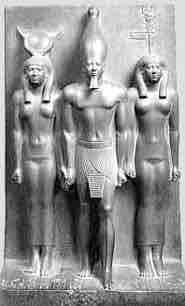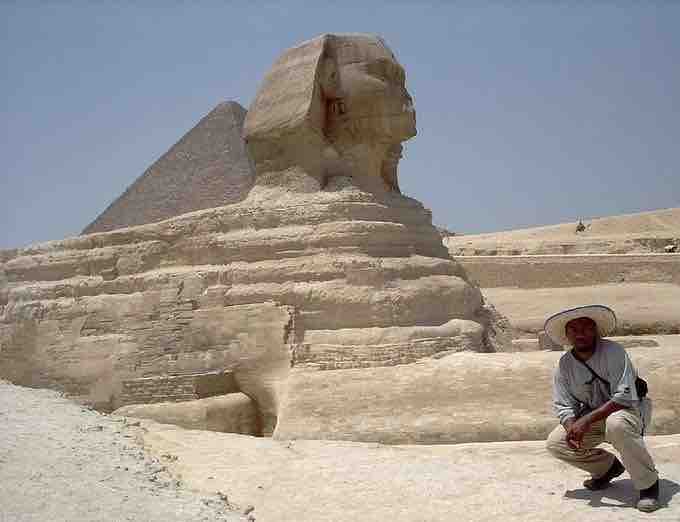Egyptian sculptors created the first life-sized statues and fine reliefs in stone, copper, and wood. They perfected the art of carving intricate relief decoration and produced detailed images of animals, plants, and even landscapes, recording the essential elements of their world for eternity in scenes painted and carved on the walls of temples and tombs. Kings used reliefs to record victories in battle, royal decrees, and religious scenes, and sculptures of kings, goddesses, and gods were common as well. Sculptures from the Old Kingdom are characteristically more natural in style than their predecessors. Toward the end of the Old Kingdom, images of people shifted toward formalized nude figures with long bodies and large eyes.

Egyptian sculpture of the Old Kingdom
This sculpture was created in the Fourth Dynasty, and represents the goddess Hathor, King Menkaure, and the goddess Bat.
The Great Sphinx, located among the Pyramids of Giza, is the largest monolith statue in the world, standing 241 feet long, 63 feet wide, and 66.34 feet high. Carved out of limestone, it represents a mythical creature known as a sphinx, with a lion's body and a human head. It is commonly believed that the head of the Great Sphinx is that of the Fourth Dynasty (2680-2565 BCE) pharaoh Khafre, whose pyramid stands directly behind the giant sculpture.

The Great Sphinx of Giza
The Great Sphinx, located among the Pyramids of Giza, is the largest monolith statue in the world.
While most sculptures were made of stone, wood was sometimes used as a cheap and easily carved substitute. Paints were obtained from minerals such as iron ores (red and yellow ochres), copper ores (blue and green), soot or charcoal (black), and limestone (white). Paints could be mixed with gum arabic as a binder and pressed into cakes, which could be moistened with water when needed.
By the Fourth Dynasty, the idea of the ka statue was firmly established. Typically made of wood or stone, these statues were placed in tombs as a resting place for the ka, or spirit, of the person after death. Other sculptural works served as funerary art, accompanying the deceased in burial tombs with the intention of preserving life after death. Strict conventions that changed very little over the course of Egyptian history were intended to convey the timeless and non-aging quality of the figure's ka.

Ka statue of Horawibra
The Fourth Dynasty also witnessed the production of so-called "reserve heads," plain and hairless naturalistic busts found primarily in non-royal tombs. Each head bears a striking individuality despite many common features, leading to the argument that they were portraits. Some scholars believe that they were intended as the commoners' equivalent of ka statues, although the exact purpose remains a matter of debate.
Reserve heads (c. 26th century BCE)
These individualized busts might have been the commoners' equivalent of the ka statue, but the exact purpose remains unknown.
Very strict conventions governed the crafting of deity figures, and these rules were followed so strictly that over three thousand years, the appearance of statues changed very little. For example, the sky god (Horus) was to be represented with a falcon's head, while the god of funeral rites (Anubis) was to be always shown with a jackal's head.
In addition to funerary art, Egyptians surrounded themselves with objects to enhance their lives in this world, producing cosmetic vessels and finely carved and inlaid furniture. Over time, Egyptian artists adopted a limited repertoire of standard types and established a formal artistic canon that would define Egyptian art for more than 3,000 years while remaining flexible enough to allow for subtle variation and innovation.